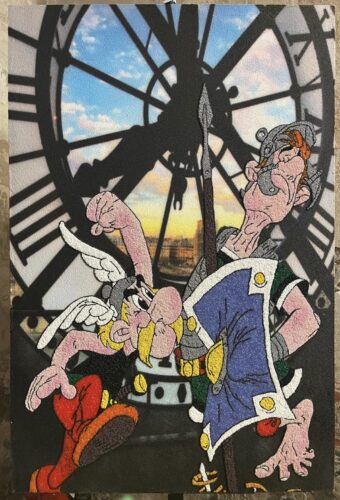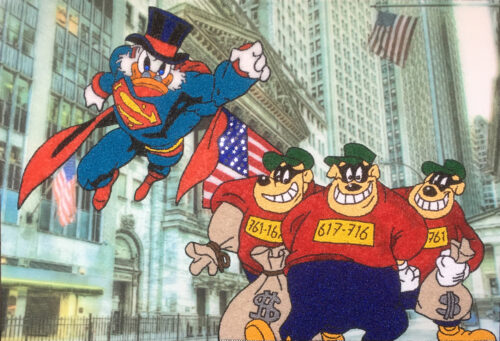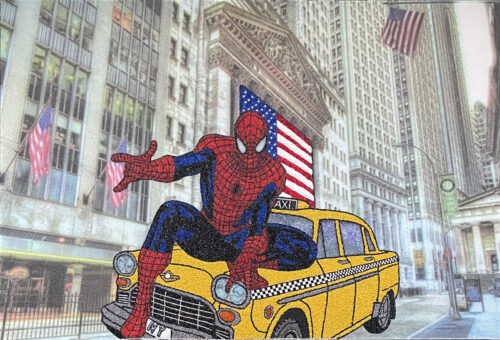In TIMEWARPED, Roberto Carullo invites us to slip between the panels of comics and the folds of time. His artwork is a layered meditation on memory, media, and myth, with characters lifted, literally and metaphorically, from their narrative contexts and suspended mid-story. The exhibition weaves past, present, and speculative futures into a textured visual language shaped by comics, recycled materials, and a practice grounded in cross-cultural identity. Carullo’s work returns us to the tactile and the handmade, filtered through a highly contemporary lens. His practice brings together nostalgia and critique, play and precision, constructing a body of work that invites viewers to engage both emotionally and intellectually.
The exhibition’s title evokes a vision of time and place not as a straight path, but as overlapping frames.
“My work plays a nice role between present, past and future, it simply brings back memories of joyful moments to people of a certain age (past) and makes today’s kids try to raise awareness. (Present) hoping it’s good advice for the future.” – Roberto Carullo
Carullo highlights familiar figures from European, American, or Japanese comics, appearing mid-motion, foregrounded in vibrant 3D while moments of New York City emerge in the layered visuals behind them. These scenes are far from flat. His backdrops are constructed environments with recognizable architecture and meaning. He strategically chooses iconic NYC landmarks, like Wall Street or Times Square, for their global familiarity. “… and if the public does not know the character I insert in the painting,” he notes, “they will surely know the city, and so I will capture their curiosity.” In this way, the city becomes an anchor, a shared cultural touchstone that invites deeper exploration and connection.
The figures themselves are sculpted from fragments of recycled polymers, adhered onto canvas in a tactile, labor-intensive process. In an era marked by overproduction and environmental degradation, Carullo’s use of discarded plastic is both material and message. The result is a mosaic that’s luminous, layered, and heavy with cultural residue. Memory becomes tangible, waste becomes narrative, and nostalgia gains mass. He transforms what has been discarded, physically and symbolically, into figures that float, resist, and reassert their presence. These works challenge our disposable culture while celebrating the enduring power of myth, comics, and imagination.
In one standout piece featured in this exhibition called Asterix al Muse d’Orsay, Carullo turns to one of France’s most beloved comic icons: Astérix, the clever and rebellious Gaul who has long symbolized underdog defiance. Astérix is frozen mid-action, his fist raised in classic comic bravado, facing off against a lanky, dazed Roman soldier. Their interaction is full of humor, exaggerated, and deeply emblematic of the series’ original satire. Behind the characters looms the immense clock face of the Musée d’Orsay, one of Paris’s premier institutions of fine art. The museum’s ornate metal framework and expansive view of the city stretch across the background, anchoring the action in a high-cultural context. Astérix, created by René Goscinny and Albert Uderzo in 1959, has always embodied national resistance, cultural pride, and clever triumph. In Carullo’s hands, that legacy is both honored and recontextualized. Here, Astérix doesn’t just battle Romans; he enters the contemporary visual dialogue between street art, museum culture, and mass media. The museum clock becomes a kind of temporal portal, collapsing time and tradition, much like the exhibition itself.
While based in Italy, Carullo maintains a vivid connection to New York—a city that recurs throughout his work like a central character. His practice flows between geographies, bridging tactile tradition with media-saturated mythology. Cities don’t just live in maps, they live in the collective imagination, projected through comics, film, and pop iconography. Roberto uses that shared visual archive and reanimates it through his own lens.
When I asked about his piece called La Banda Bassotti (The Dachshund Gang), a vivid work of art where Scrooge McDuck is suited like Superman and soars over the infamous Beagle Boys with their prison numbers clearly visible on their chests, set against the neoclassical architecture of New York’s Wall Street, Carullo described the work as “a mix of emotions that makes you think.” Measuring 80 by 120 centimeters and rendered on tela intonacata (plastered canvas), the piece is both visually bold and thematically layered. Here, Scrooge is reimagined not as a hoarder of wealth, but a potential force for good. “Money itself is not to be demonized,” Carullo explains. “It can feed people, support education… the rich can become heroes, if they choose to act.” The tension between power and morality, wealth and justice, is made through iconography and material. The use of discarded plastics to form these familiar figures gives them an added layer of critique: the symbols of economic and cultural excess are literally made from society’s waste. And true to Carullo’s distinctive style, the characters are constructed from fragments of recycled polymer, hand sculpted into mosaics on the surface with painstaking detail. These layered materials give the figures a weight and physicality that contrasts sharply with the airbrushed background, where the façades of finance pulse in cinematic perspective. The American flag flutters in the background, signaling the broader cultural and political terrain in which Carullo is operating.
Other works in the exhibition expand this narrative field in distinct ways. In Un Passaggio a Wall Street, Spider-Man stands atop a bright yellow taxi, posed mid-web-sling in his iconic stance, set against the Wall Street backdrop. The scene, built from layered textures and sculpted recycled polymer, turns Wall Street into a comic strip stage — part myth, part monument. Similarly grounded in the financial epicenter of Manhattan, The Wolf of Wall Street, draws from a different branch of pop culture: contemporary film. Carullo blends satire and spectacle, placing Leonardo DiCaprio’s iconic character mid-toast, glass raised, with looming skyscrapers in the textured background. Suspended nearby is Spider-Man again, this time hanging from an American flagpole, sculpted from plastic and staring directly at the viewer, a symbol of resistance or complicity, depending on your angle. In Tiffany, Catwoman dangles upside down in front of the iconic jewelry storefront. Her gleaming suit and red handbag drip with high-femme flair, turning the luxury brand into a playground for fantasy, aspiration, and critique. These works, while playful, carry serious weight.
The careful staging of these figures is never accidental. As we’ve seen in Asterix al Musée d’Orsay, where the rebellious Gaul confronts cultural authority before the clock of a famed museum, and in La Banda Bassotti, where Scrooge McDuck soars above Wall Street in superhero drag, Carullo’s character placement is as conceptually charged as it is visually compelling. That same strategic symbolism appears again in Tiffany. Here, Catwoman dangles upside down in front of the iconic jewelry storefront, her gleaming suit and red handbag rendered with a high-femme flair that turns the luxury brand into a site of layered meaning—both playground and battleground. Choosing a female comic anti-hero, known for navigating power on her own terms, Carullo reimagines consumer fantasy, aspiration and critique.
By highlighting characters and architecture from a wide range of traditions he creates bridges between cultures, geographies, and generations. These characters break the frame, disrupt the narrative, and reclaim space not just on the canvas, but in the cultural imagination. In many ways, they act as stand-ins for a broader cultural psyche. These figures are carefully constructed from recycled polymers, layered over the surface of the canvas, floating above their landscapes and rising with weight and whimsy. They are familiar yet transformed. Recycled, reanimated. Timewarped.
Carullo’s work offers something rare: a space where reflection meets reinvention. Through comic logic, sculptural form, and narrative depth, TIMEWARPED becomes more than an exhibition. It becomes a lens on how we remember, how we imagine, and how we might transform the stories we think we know. The artist’s connection to comic history runs deep—not just through influence, but personal experience. Years ago, Carullo met Stan Lee’s assistant, who shared his paintings with the Marvel icon. In response, Carullo created a portrait of Lee, which the legendary storyteller received with enthusiasm. “He wrote to me,” Carullo recalls, “thanked me, and said he wanted to see all of my Marvel character works. He complimented my art.” It’s a moment that connects Carullo’s practice directly to the mythmakers he honors, and speaks to the spirit of collaboration, admiration, and imagination that animates his work.
And while these works speak powerfully through images, they are meant to be seen in person. The texture, dimension, and intricate craftsmanship behind each piece can only be fully appreciated up close. I encourage you to visit in person and experience the full force of Carullo’s vision for yourself:
The exhibition runs from June 9 to 30, 2025, with an opening reception on June 12 from 6–9 PM at Studio 511, 526 W 26th St, 5th Floor, Chelsea. Gallery hours are Tuesday through Saturday, 12–6 PM.






